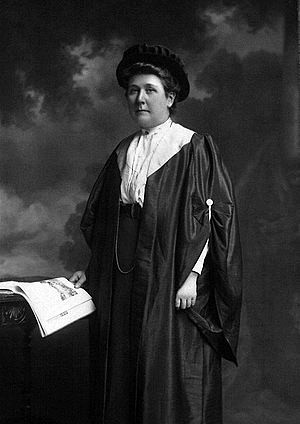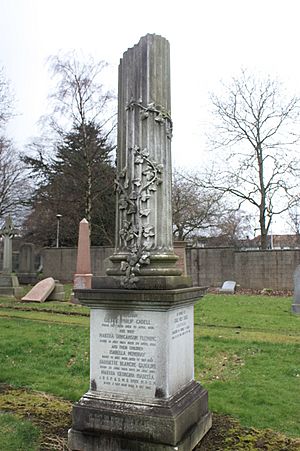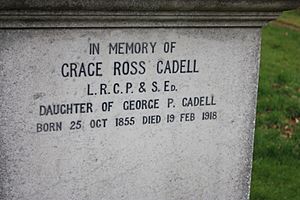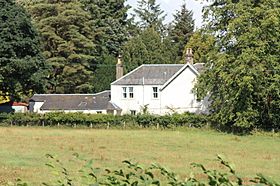Grace Cadell facts for kids
Grace Ross Cadell (born October 25, 1855 – died February 19, 1918) was a brave Scottish doctor. She was one of the first women to study medicine in Scotland and become a qualified doctor. Grace was a determined person. She even stood up to her teacher, Sophia Jex-Blake, and won a lawsuit against her school.
Grace Cadell spent her career helping women and children. She was also a strong supporter of women's rights. She actively campaigned for women to get the right to vote, known as women's suffrage. Her home became a safe place for other women who were fighting for the same cause.
Contents
Early Life and Education
Grace Cadell was born on October 25, 1855. She was the oldest of four daughters. Her father, George Philip Cadell, worked at a coal mine in Bo'ness, Scotland.
In 1887, Grace and her sister Martha Georgina Cadell, known as 'Ina', started studying medicine. They joined the first group of students at the Edinburgh School of Medicine for Women. This school was started by Sophia Jex-Blake in 1886. Students learned in classrooms and also at Leith Hospital.
Standing Up for Herself
Sophia Jex-Blake was very strict. She had a rule that students had to leave Leith Hospital by 5 PM. On June 8, 1888, Grace and Martha Cadell, along with two other students, stayed late. They wanted to keep watching a patient with a head injury.
When Jex-Blake found out, she expelled Grace and Martha from the school. But the sisters didn't give up! They decided to sue Jex-Blake and the school. In July 1890, the court agreed with them. Each sister was awarded £50 in damages. This event caused a lot of talk and was a big problem for Jex-Blake's school.
New Beginnings in Medicine
Another student, Elsie Inglis, was also unhappy with how Jex-Blake handled things. Elsie left the school in 1889. With help from her father, John Inglis, Elsie started a new school. It was called the Edinburgh College of Medicine for Women.
Grace and Martha Cadell joined Elsie Inglis at this new college. They both did very well in their studies. Martha won a medal for her work in midwifery (helping with childbirth). Grace won a medal for medical law.
In 1891, Grace Cadell passed her medical exams. She earned a special qualification called the 'Triple Qualification'. This allowed her to become a registered doctor. At that time, women could not yet graduate from Scottish universities with a medical degree. This qualification was a way for them to practice medicine.
Medical Career and Helping Others
After qualifying, Grace Cadell started working at the Edinburgh Hospital for Women and Children. This hospital had only female staff. Grace was appointed as a surgical resident, meaning she helped with operations.
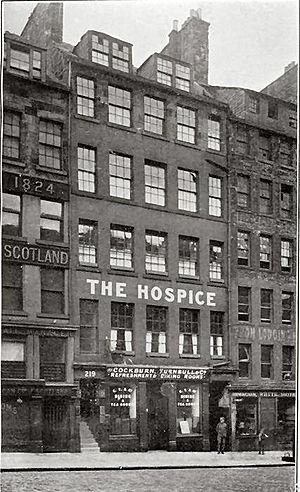
In 1899, Elsie Inglis created the Medical Women's Club. Its main goal was to open a hospital for women. Grace Cadell was an important member of this club. She later served on the medical committee of the new hospital.
In 1904, Grace joined the staff of The Hospice. This was another hospital for women and children on Edinburgh's Royal Mile. She became a specialist in obstetrics (care during pregnancy and childbirth) and gynaecology (women's health). In 1911, she took charge of the entire clinic. Later, she also worked at a hospital in London.
Fighting for Women's Rights
Grace Cadell was a very active suffragette. Suffragettes were women who campaigned for the right to vote. On October 9, 1909, Grace joined a large march in Edinburgh. They were demanding "Votes for Women!"
She was the president of the Leith branch of the Women's Social and Political Union (WSPU) in 1907. Later, she joined the Women's Freedom League (WFL).
Acts of Defiance
Grace often showed her defiance. In 1912, she refused to pay her taxes as a protest. As a result, her furniture was taken and sold publicly in Edinburgh. Grace used this event to hold a suffrage meeting.
During the Scottish Suffrage Campaign of 1913-14, Grace was a medical advisor. She helped suffragettes who were on hunger strike in prison. Under a law called the "Cat and Mouse Act," prisoners who were very ill were released. They were allowed to recover before being sent back to prison. Grace often took care of these women, including Ethel Moorhead, Edith Hudson, and Arabella Scott.
In another act of protest, Grace refused to stamp the insurance cards for her five servants. This was a way of protesting government rules. She was fined £50 in court. The trial was in the newspapers because other suffragettes threw apples at the judge! Grace paid her fine with a sack full of copper coins. This was another way to show her strong feelings.
Her house at 145 Leith Walk became a safe place for suffragettes. It was known as a sanctuary where they could find refuge. Grace never married. However, during the First World War, she adopted four children.
In July 1914, Grace attended the trial of Maude Edwards. Maude was accused of damaging a painting of King George V. Grace was so passionate during the trial that she had to be removed by police officers. She was not arrested.
Death and Lasting Impact
Grace Cadell passed away on February 19, 1918, at Mosspark House in Yetts o'Muckhart. She was buried with her family in Morningside Cemetery.
Grace left a large sum of money in her will, over £50,000. This was a lot of money back then! She left it to charity, her family, and her four adopted children. One of her adopted children, Grace Emmeline Cadell, was named after Emmeline Pankhurst, a famous suffragette leader. The will gave each adopted child £150 per year for their lives. This was about four or five times what an average person earned each year.
In 2009, people re-enacted the sale of Grace Cadell's furniture. This event took place at the Mercat Cross in Edinburgh. It was part of a play called What Women Want, which told stories of the suffrage movement in Scotland.
Family Connections
Grace's niece, Isobel Cadell (1890–1971), married Harry MacDonald Simson. Harry was a cousin of Sir Henry Simson, a well-known doctor. Sir Henry Simson was also a cousin of Elsie Inglis. This means Elsie Inglis was Grace Cadell's second cousin.


